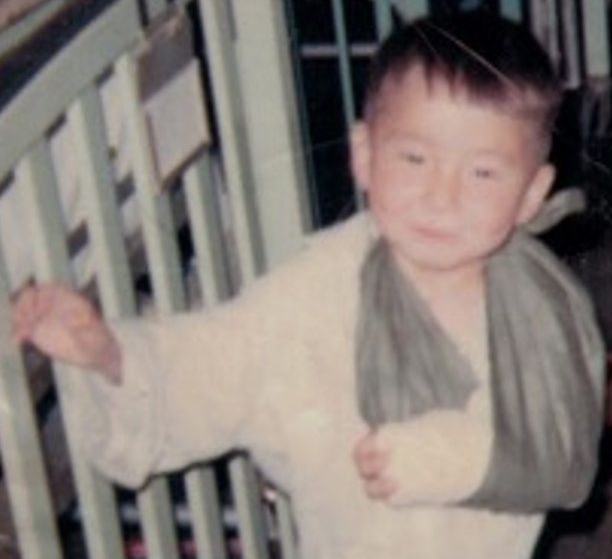
The author after surgery
I was nearly boiled to death as a six-month-old infant.
I fell into a pot of boiling-hot water, immersed in it for nearly an hour — alone and unsupervised. This traumatic event, literally scarred me for life. Physically for sure, but also emotionally and psychologically.
Dysmorphohpobia — It’s a word that most people have never heard of, yet we all are touched by it — some very much, most at least a little. The word has two simultaneous meanings: the fear of acquiring a deformity and the fear or revulsion of deformity in someone else.
Although I had never heard the word, dysmorphophobia, growing up, I was far too intimately familiar with its two meanings. According to the World Health Organization, there are more than 11 million burn victims who required medical treatment worldwide each year. Nearly all of them too become acutely aware of the meaning of this word that no one has heard of.
Fear of and repulsion by disfigurement is based on universal, evolved innate human reflexes.
These evolved reflexes are then reinforced by social and cultural norms and stigmas. Literally, people can’t help their reactions.
But those who live with deformity — especially a visible one, and particularly if it is on the face or the hands — confront daily the painful effects of these innate and socially reinforced reactions in the people around them. Those with deformities often find that their life’s chances for success in work, dating, marriage, friendships and society are negatively impacted and possibly severely limited.
Deformity is a land unwanted.
Having a deformity doesn’t suddenly make one not be dysmorphophobic toward others, though it may make one more sympathetic. Likewise, few rarely find pride in being disfigured. To be sure, some take pride in their ability to cope or overcome their deformity, but the disfigurement itself is rarely a source of pride.
There is no pride of membership, of belonging, of citizenship in the land of the misshapen, the disfigured.
But there are things people can do to ease the life of someone who has a deformity.
Here are five simple things:
1. Never point.
2. Don’t take sneak looks while talking to the person.
We will notice your flitting eyes. We have lots of practice spotting them. If you are engaged in a conversation and find that you can’t help but notice, then simply say so and ask — neutrally — what happened.
3. Don’t take notice of a child’s deformity or ask a child about it if you are an adult. If it is a natural, appropriate circumstance, and if you must, ask the parent. Never the child.
4. Don’t lie and say that you’ve never noticed.
It’s OK to say that you noticed it, but that it’s not the focus of your attention when you’re interacting with the person. If that is true, it’s a good thing.
5. Don’t talk about how you know someone who has the exact same or similar deformity and how great a person he or she is.
The deformity shouldn’t define the person or make it surprising that a person with a deformity is wonderful or the opposite. Telling someone that another person has the same misfortune really is meaningless to the person who must live with a deformity every day.
Dr. Martin Luther King, Jr.’s dream that one day people may be judged by the content of their character and not the color of their skin may come to pass. But it is unlikely that this dream will apply to those who are scarred, misshapen, disfigured or deformed. Evolution has stamped indelibly into the human brain innate reactions. And social reinforcement likely runs too deep.
It is better to acknowledge that we are all, to one degree or another, dysmorphophobic.
It’s like acknowledging that one is allergic to something. The item to which one is allergic is not the cause of the problem, per se. An allergy is caused by the body’s reaction to something — it is the body’s innate reaction that causes the problem.
Animals cannot help their reactions to situations and cannot constrain their behaviors in response to their reactions of fear or revulsion. We humans, being a part of the animal kingdom, cannot help our feelings and internal reactions — our fears and revulsions.
But how we act, behave, and respond to our fears and revulsions is a choice governed by our intellect and thus can be the defining element that makes us truly human and truly humane.
Share this article via Facebook and Twitter.
Joel L. A. Peterson is the national award-winning author of the novel, Dreams of My Mothers (Huff Publishing Associates, March, 2015).
-- 1st Place Winner, 2015 Readers' Favorite National Book Awards (Gold Award)
-- Foreword Reviews’ 2015 INDIEFAB Book of the Year Award Winner
“Compelling, candid, exceptionally well written, Dreams of My Mothers is a powerful read that will linger in the mind and memory long after it is finished. Very highly recommended.”
— Midwest Book Review
Learn more about the author and his book at Dreamsofmymothers.com and on Facebook
